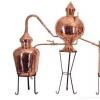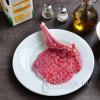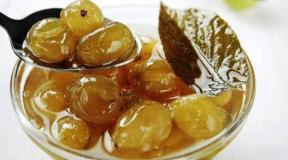Home brewing. Equipment selection and recipes
In our country, the technology of home brewing has been mastered by almost the entire working-age population. And it is strange to blame the Soviet government for this, or rather personally MS Gorbachev, who invented the "dry law", since we cooked, we cook and will cook it, regardless of anything. Of course, only a few abuse the drink, the rest prefer to enjoy the quality of real moonshine and elite drinks made on its basis.
Why are we talking about quality? Because for many, moonshine is associated with a cloudy, foul-smelling liquid that is dangerous even for external use. In fact, the process of home brewing in compliance with the technology gives a crystal clear strong drink with a pronounced taste. In the article we will describe the basics of home brewing and tell you what this process is all about.
Basic terms
Much of what will be listed below is known to the majority, but nevertheless, for accuracy and further understanding, you must first understand the terms.
- Moonshine - a transparent drink with a strength of 48-60 °. Initially, it has a neutral alcoholic taste; third-party aromas are added during the infusion.
- Home brewing - the technological process of obtaining an alcoholic beverage, in the process of which mash is brewed.
- Braga - a sugar-containing wort that is made from processed yeast and a selected main product. The fermentation process produces ethyl alcohol, gas and by-products.
- Alcohol mashine - a design for obtaining an alcohol-containing liquid by cooking mash, during which the composition is divided into fractions. Consists of a distillation cube, a cooling unit, a coil and an accumulator (collector).
- Pervach - alcohol-containing liquid obtained during the first distillation of the mash. Contains toxic impurities, is characterized by a cloudy color and a pungent odor.
- "Heads" - the concentration of methanol and acetone boiling at lower temperatures than ethanol. In the process of fractional distillation, they are cut off and their number is reduced to a minimum.
- "Tails" - fusel oils, which are separated at a higher temperature than that created in the distillation still. They are also cut off during the re-distillation process and additionally settle in a dry chamber when leaving the refrigerator.
Separately, it should be noted that the quality of the drink directly depends on the amount of distillation. The saying “Less is better” here works 100%.
The main stages of home brewing
The rules of home brewing fix 4 main stages in the preparation of this wonderful drink:
- Preparation of raw materials.
- Fermentation.
- Distillation of mash.
- Purification of the resulting drink
- Aromatization is an optional but recommended step for enhancing the flavor and giving it a bright aroma.
For those who are just mastering the basics of moonshine, it is advisable to have a fully equipped apparatus, where there is:
- a hydrometer for determining the strength of the finished drink;
- a thermometer to control the distillation temperature;
- manometer - a device for measuring the pressure in the distillation cube.
Classic types of raw materials and methods of their processing
As it is written in the immortal novel "The Twelve Chairs", moonshine can even be made from a stool, and it will be a stool. Modern production does not offer such extreme measures, and therefore the best products for obtaining a good wort will be starch and sugar-containing ingredients.

Depending on the time of year and financial condition, the following are used to prepare the wort:
- corn;
- potatoes;
- sugar;
- fruit and berry cake;
- berries and fruits, etc.
Starchy foods
The highest quality is grain, in particular wheat, for good reason, it is wheat vodka that has always been a priority. In second place are whole fruits and berries, from which soft drinks with a low alcohol content are made. Potatoes also give a mild flavor, but less intense aroma. The most unpleasant thing will be moonshine made from sugar beet and cake, but such a drink is also prepared and consumed.
Concentration of starch and sugar in grains and roots:
All of these foods contain high concentrations of starch. In order to convert starch into glucose, a gelatinization technique is used - first, the product is abundantly moistened, then it is heated to remove the starch and transfer it to a water-soluble state. Next, you need to saccharify the resulting paste, for which you use malt (the procedure itself is described below in the "Fermentation" section).
If you do not use malt or special enzymes, the wort will simply turn sour, and the drink itself will have a disgusting taste.
In order to prevent souring, do the following.
- Raw materials are soaked so that it was possible to cook a liquid porridge.
- It is boiled to the state of "aldente" - when the grains or roots are not yet completely boiled.
- Malt or enzyme preparations for saccharification are added.
- Yeast is added and sent for a certain time until the wort ferments.
- Distilled mash and get moonshine.
VIDEO: How to make mash with wild wheat yeast
These are the ingredients for making wort with a high sugar content. They mainly use apples, grapes, raspberries, viburnum and other berries. The cake also contains a large amount of sugar, but it is not enough to obtain high-quality raw materials.

The concentration of acid inhibits the activity of acids, so sour berries and fruits are first boiled to neutralize the acid, and then baking soda is added at the rate of ≈20 g. per liter of wort.
In order to understand exactly which raw material is better to work with, we present the tabular values \u200b\u200bof the yield of alcohol (96%) and vodka (40 °) for individual products. The data was derived by distiller Waldemar Strieter (Germany).
Fermentation stage
The longest stage that already precedes the actual distillation. In the process of fermentation, ethyl alcohol, water and CO2 are formed, which are divided into fractions during distillation.
The fermentation time directly depends on the amount of sugar in the prepared wort, but it should not be too much - as soon as the ethyl concentration exceeds 10 °, fermentation stops. And vice versa. If there is not enough sugar, ethyl is released extremely slowly and little, so the mixture can simply sour.
Saccharification procedure
If you work with starchy foods (grain, potatoes or pure starch), saccharification must be carried out correctly and there are certain subtleties here.
- The starch is diluted with water to a liquid state.
- Pre-boil water, where water with starch is slowly poured in a thin stream, stirring constantly and not allowing the paste to form.
- When all the starch is poured, turn off the stove, and put the cup with the solution in cold water. It must be cooled to a temperature of 68-60 ° C. Next, add malt, malt milk or ready-made enzyme products.
How to make malted milk
- Grain (wheat, rye, barley) is pre-germinated.
- Sprouted grain is well dried and pounded until a gruel is formed.
- Dilute with water until creamy.
After the starch solution and malt milk have been mixed, the bowl with the liquid is left for 3-3.5 hours in a warm place. It is advisable to use a battery or wrap it up with a blanket - the temperature should remain at around 60 ° C. That's it, this is the end of the starch saccharification process.
How to choose yeast

It is in the process of the vital activity of mushrooms that ethyl alcohol is released, respectively, you need:
- Choose the right yeast
- Use the correct concentration.
If there is a lot of yeast and a large amount of ethyl (more than 13%) begins to be released, the remaining mushrooms will die and the fermentation stage will not reach a certain end.
To prepare high-quality mash, you need "live" yeast - pressed, fresh, moist with a characteristic aroma. The color is uniform, the edges are not dry. Dry yeast is of little use - although it is also a living single-celled organism, their concentration is not enough to obtain high-quality raw materials.
During the entire fermentation procedure, you need to maintain a certain temperature of 18-30 ° C. To do this, put the vat with the mash in a warm place, but at the same time, control so as not to exceed the 30 ° mark, otherwise the mushrooms will die. If suddenly this happens, carefully drain the top layer and add fresh yeast.
It is possible to determine that the wort is ready for distillation by its appearance and smell:
- the taste of the mash is bitter with a slight sour aftertaste;
- there is no foam or air bubbles on the surface;
- the smell is sweetish, but rather mild.
Distillation process
The technology of home brewing is not limited only to this stage, but this is precisely the very mechanism for obtaining ethyl alcohol from fermented mash.

For this purpose, a moonshine still is used - it can be both home-made and factory-made.
The mash itself is poured into a sealed alembic, where it is heated to a certain temperature. The purity and content of the drink depends on how correctly the temperature is maintained at each stage.
The whole process can be divided into the following stages (distillation):
- Intensive heating to a temperature of 66-68 ° C, when the first impurities begin to separate. Then the temperature is gradually brought to 78 °. It is important to do this slowly so that some of the mash does not spill out.
The drink obtained during the first distillation contains more than 50% of harmful impurities, including acetone and fusel oils. Its use is fraught with food poisoning and even death.
- Maintaining the temperature at around 78-82 ° is the longest stage during which the bulk of the ethyl is released. After the second distillation, the product can already be consumed, but if not used, the concentration of fusel oils is still very high.
Periodically check the alcohol content in the collection with a hydrometer or the old-fashioned old-fashioned way - setting fire to a spoon. As soon as the liquid has stopped burning, turn off the heating.
- In millet of the third distillation, the temperature is raised to 87-90 ° C to start the separation of heavy fuselage.
Throughout the entire process of home brewing, the temperature in the refrigerator (coil) is controlled - it should not rise above 30 ° C. This balance is ensured by the constant circulation of cold water.
VIDEO: How to make high-quality moonshine
Cleaning the finished product
Since we want to teach you how to cook a pure product, you need to learn how to clean it properly. After the second distillation, even in the presence of a dry pot, it still contains a part of foreign substances that are harmful to health and taste. Experienced masters do not recommend doing the third distillation, since it removes the very taste of moonshine.
Some organic compounds cannot be removed during the boiling process of the mash - their boiling point is much higher (see table).
To get rid of the above organic compounds, several stages are practiced:
- chemical at the first distillation;
- fractional by re-distillation;
- chemical after the second distillation;
- filtration.
- At the first stage, a weak solution of potassium permanganate is used, for which they take 2 grams, dissolve in 50 ml of purified water and dilute to a liter with moonshine. Leave for about 10 minutes, then filter through a cotton cloth.
- Fractional distillation means the separation of the resulting drink into fractions again, but this does not guarantee total purification, since, for example, the isomeric amyl alcohol with the highest boiling point cannot be separated.
The concentration of heavy impurities can be reduced by diluting the drink to 45 °.
- At this stage, activated carbon or charcoal obtained from fruit logs is used. This is the highest quality method in which porous coal absorbs up to 85% of impurities.
Moonshine is poured into the container and coal is added at the rate of 150-180 gr. for every 3 liters. Insist for 15-20 days, periodically shaking strongly (at least 2 times a day). Strain through a cotton cloth.
Mastering the technology of home brewing is actually not difficult. The main thing is to observe the order, maintain the temperature and sequence at each stage. But the most important thing is to make a high-quality wort and work with a working moonshine still.
VIDEO: How to make high-quality moonshine with minimal costs
At various stages of the technological process of making moonshine, there is a need to use a whole range of special and auxiliary equipment. Special equipment includes apparatus for distilling mash, the design diagrams of which are proposed for detailed consideration. Since the distillation process is reduced to heating the raw material and condensing the resulting vapors, the entire range of different designs of distillation apparatus can be represented by one schematic diagram:
Figure 3
To get moonshine you need:
Heat container 1 so that the resulting alcohol vapors rise through channel 2;
Cool vapors in container 3 to a liquid state;
Purify the product continuously or separately;
Collect moonshine in a container 4;
Observe safety precautions.
The quality of the obtained moonshine depends not only on the raw materials, the recipe and the correctness of the technological process, but also, in many respects, on the design of the distillation apparatus. Using the general information given here, you can make a large number of the most diverse designs of moonshine stills.
The effectiveness of home brewing is to increase the yield of moonshine per unit of raw materials, reduce energy consumption, controllability of the process and improve the purification of the resulting product. Sometimes efficiency is neglected and huge costs are incurred to achieve "super quality". For example, in Russia in the XVIII-XIX centuries, up to 30 kg of wheat and rye were consumed to obtain 1 liter of moonshine.
Each of the design options proposed below has its own advantages and disadvantages, therefore, each design can be considered as a set of interchangeable modules; so, when choosing the final version of the moonshine still, it is advisable to take into account the available possibilities of using ready-made elements (for example, a pressure cooker or an enamelled tank is often used as an evaporator). It should be remembered that an unnecessarily complex design of the apparatus does not at all guarantee the quality and efficiency of home brewing. Below are some diagrams of the most common designs of moonshine stills. The first two designs (Fig. 4 and Fig. 5) belong to the class of isothermal distillation.
The principle of operation of this design is very simple: when the mash 6 is heated, the alcohol-containing steam rises until it touches the cold bottom of the basin 2, where it condenses and flows into the moonshine collection 3.

The structural diagram shown in Fig. 5, differs little from the previous one, but more effective than it, and the quality of the resulting product is slightly higher.

The device is easy to manufacture due to the use of ready-made elements, convenient for use in any conditions. The main disadvantage is the need to periodically remove the basin with the cooling liquid to remove the moonshine from the receiving container.

In fig. 6 shows the design of a moonshine still for isothermal distillation, the prototypes of which are the above presented design schemes. The meaning of the improvement lies in the installation of an additional funnel and a branch pipe, due to which it becomes possible to take the receiving container (collection of moonshine) outside the evaporator. The funnel should be placed either on a wire basket or on a tripod mounted on the bottom of the container. The joint between the refrigerator and the container is coated in a circle with a layer of dough. As a result, an explosion is prevented in the event of overpressure. In the process of work, the dough does not allow the alcohol-bearing vapors to evaporate, therefore, the room will not have a specific smell of booze, but the aroma of fresh bread.
The distillation apparatus (Fig. 7) is made from an ordinary pressure cooker. To do this, remove the valves from the lid of the pressure cooker 1, and replace them with plugs for tube 3 and thermometer 2. Tube 3 together with tap 4 is connected to a refrigerator with forced water cooling 5. The direction of water inlet and outlet is shown in the figure. The colder the water, the more efficiently the machine works. The refrigerator is connected to a receiving flask 7 glass

tube 6, having an elongated narrow end, which should reach almost to the bottom of the bulb 7, but not touch it.
3–4 cm of boiled water is poured into flask 5 and the narrow end of the glass tube of the refrigerator is immersed to obtain a water seal. The flask is then immersed in a cold water bath. Before the start of distillation, the refrigerator 5 is connected to a water tap by means of hoses and water is released. After that, they begin to heat the mash, gradually adding fire until it boils. After the mash boils, the heating rate is reduced and a uniform intense boiling is achieved.
After filling the receiving flask 7 about half it is lowered so that the end of the refrigerator tube is not immersed in the moonshine, and the distillation is continued without a water seal. At the end of the distillation, the heater is turned off, the apparatus is disassembled and the container and channels are washed.
The design of the apparatus for the distillation of home brew (Fig. 8) differs in compactness and admissibility of a complete set of individual elements, but has a low productivity.
This version of the apparatus is used for the distillation of mash and flavored solutions in small quantities (0.2–0.5 l). On an asbestos sieve 2, fixed in a tripod 1, put

flask 3 with stoppers tightly fixed in the necks. A hole is made in the upper stopper for a thermometer 4, and in the side one for a tube 6 with a tap 5, which connects the flask with a condenser 7. Flask 3 is chosen such that the liquid to be distilled occupies 2/3 of its volume.

Figure 8 shows a structural diagram of the apparatus, similar to the previous one.
The apparatus uses a water bath 1, a drop catcher 3 and a special type of refrigerator with forced water cooling 6. Flask 2 is placed in a container with water 1, thereby creating a water bath. Pieces of ceramic are placed in flask 2, which ensures uniform boiling of the mash. Droplet separator 3 catches liquid drops that enter the pipeline along with steam, as a result of which the concentration of syrup increases. The direction of movement of water in refrigerator 6 is shown in the figure.

This is the most widely used option. It is also called a distillation cube or a distillation cube with a coil.
The distillation cube consists of a large container 1, which is closed by a lid 2, where a thermometer 3 and a pipeline 4 with a tap 5. The pipeline is connected to a coil 6 immersed in a tank 7 with cold water. In the tank 7, the water is made flowing whenever possible. The productivity of such a device is 0.6–0.8 liters per hour. After a single distillation, the concentration of moonshine is obtained in the range of 32–42.
Container 1 is filled with water no more than 2/3 of its volume and brought to a boil. They often make such a mistake: they approach the boiling point (78 ° C) with an unreasonably high heating rate. As a result, the mash "spits out" into the pipeline, after which the distillation stops. To bring the device into working condition, it is necessary to flush the "soiled" pipeline.
It will be correct to conduct the process as follows: when the temperature of the mash rises to 75 ° C, the heating rate is reduced and such a stable boiling is achieved so that the heating is fully controlled.

This version of the device includes an additional container with water for cleaning and increasing the concentration of moonshine. It consists of a container 1, two thermometers 2, a tube 3, which serves to protect against a sudden increase in pressure, a pipeline 5 with a tap 4, an additional container 6, a refrigerator 7 and a flask for the product 8.
Here, the following sequence of operations should be observed: first, water is heated in container 6, then the raw material is heated in container 1 and distillation begins. Alcohol-containing vapors, which are a mixture of alcohol vapor and water vapor, pass through tank 6, where the water temperature is maintained at 80–82 ° C (the boiling point of alcohol is 78 ° C)
When the vapor passes through the water, the water component of the vapor condenses and remains in the tank 6, and the vapors of the moonshine, getting rid of the water, are concentrated. Then the alcohol vapor enters the refrigerator 7 and, condensing, flows into the flask 8.
Naturally, some of the alcohol vapors are condensed in tank 6, so the water here is enriched with alcohol. At the end of the distillation, water from container 6 must be poured into container 1 and distilled again.
Various designs of moonshine still belong to the main equipment, but for the normal provision of the entire technological process of obtaining moonshine, a number of auxiliary equipment is required: various containers for preparing mash, connecting hoses, thermometers, filters, etc.
Dephlegmator. Under industrial conditions, high-quality alcohols are obtained using a rectification column. Rectification is the separation of evaporation products into separate components according to the boiling point. The design of the distillation column is rather complicated, it requires strict adherence to the temperature regime and forced injection of vapors released during distillation. Its use is advisable only for large-scale production.
At home, a reflux condenser can be used to obtain a known high-quality moonshine in terms of chemical composition (Fig. 12).

A dephlegmator is a device for separating vapors of the basic substance (in our case, ethyl alcohol) of substances boiling at a higher temperature (fusel oils). The principle of its operation is to use a temperature gradient over the entire height of the reflux condenser, moreover, the height for each design of the moonshine is selected in such a way that the temperature of 78 ° C is constantly maintained in the upper neck of the reflux condenser, which corresponds to the boiling point of ethyl alcohol. Vapors with a lower boiling point are deposited at the lower levels of the reflux condenser and again enter the evaporator.
Thermometers. A conventional thermometer can be used to control the temperature of the mixture during fermentation, while distillation requires special thermometers with a scale of up to 120 ° C.
Hydrometer. To determine the percentage of alcohol or the so-called "strength" of the drink, a special device is used - a hydrometer, which measures the specific gravity of a liquid, with a measurement range of 0.820 -1.00.
It should be remembered that moonshine obtained from various raw materials, as well as infused with various additives, with the same alcohol content, can significantly differ in specific gravity. Therefore, hydrometer readings do not always correspond to reality.
The hydrometer can be made by yourself. For this, a small heavy weight (shot, pieces of lead) is placed in a test tube 60–90 mm high and closed with a stopper. A thin wooden rod 100–150 mm long is inserted into the cork. The test tube is placed in a container with distilled water at a temperature of 20 ° C and, by changing the weight of the load, the thin rod is almost completely hidden in the water. In this position, a mark is made on the rod. To determine the upper limit of measurement, the device is placed in a calibrated alcohol solution with a concentration of 80 °. The distance between the upper and lower limits is divided into a certain number of parts (for example, 10). The device is ready.
Capacities, containers. It should be remembered that not all utensils can be used for home brewing. The best containers are an oak barrel, a glass bottle, and an enamelled cistern. The use of aluminum cookware is allowed for a short time. Various plastic containers can only be used if they are labeled "for food". The use of copper and iron containers is completely unacceptable.
Connecting elements and seals. When using any design of a moonshine still, it becomes necessary to use various tubes, hoses, plugs, etc. It should be remembered that the products of fermentation and distillation are chemically active substances, therefore, to connect individual units of equipment, if possible, use stainless steel, glass or special rubber.
If you are not sure that you have enough knowledge, energy and time to engage in moonshine - this article is for you!
The easiest recipe for sugar mash.
How to put the mash
We need:
- Fermentation vessel made of food-grade material (food-grade plastic, glass, stainless steel, aluminum milk cans, etc.)
- Sugar
Training
If you use our 30L fermentation tank, you can prepare about 20-25 liters of home brew in it. We buy bottled water (or we can use it from the tap, but always filtered), spring or well water. We need 20 liters. Heat the water a little to about 35-40 degrees C. It is easier to dissolve sugar in warm water. Add 5kg to the water. sugar, at the rate of 1: 4, stir until completely dissolved. We will get about 23 liters of wort.
Then we prepare the yeast for introduction. It is better to use specialized yeast. in comparison with conventional bakery, they benefit from many factors:
- The yeast smell is less and usually more pleasant, which ultimately affects the quality and taste of the moonshine;
- Less foaming
- Because specialized yeast more resistant to alcohols, the brew will be stronger and, accordingly, the final product yield will be higher
- Brie-fermented spirit yeast produces fewer harmful impurities.
Calculating the amount of yeast needed is quite simple: for 1 liter of wort, we need about 3.5-4.5 grams of alcoholic yeast. Accordingly, 23 liters. mash we need 80-100 gr. yeast. Pour 1 liter into a small bowl. warm, but not hot water (30-35 degrees C) and dissolve 50g in it. Sahara. Then we add our yeast. After a while, bubbles will begin to appear on the surface, which means the yeast has begun to work.
We wait for about 10-15 minutes and pour the resulting substance into the wort we have prepared. We close the container hermetically and put in a water seal. Pour some water into the odor trap.
Fermentation will start in 10-30 minutes. For the first two days, it is advisable to stir the mash, since a film forms on top that interferes with the flow of oxygen.
The fermentation activity can be monitored by the operation of the water seal, the more often it works (gurgles), the more active fermentation is.
The fermentation process can take from one to three weeks. You can also determine the end of fermentation by the activity of the water seal. You can find out whether the mash is ready or not in two ways: by taste (the mash should not be sweet, otherwise not all sugars have been processed and yeast will need to be added to resume fermentation) and using a sacrometer (reading 0-2%).
When the mash is ready, you can take it out into the cold (but not frost) for clarification, if there is no such opportunity to give it, just stand for a couple of days so that the yeast that is actively working sinks to the bottom and does not get into the distillation cube and spoil the taste of the moonshine.
Distillation
Pour the settled home brew into a distillation cube. The easiest way to do this is with a hose, so as not to touch the yeast sediment. We fill the tank of the moonshine still by ¾, for example, 12 liters. fill the tank with 9 liters of mash We install the distiller on a cube and put the moonshine still on the heating source, supply cooling water, and fill the refrigerator with cold water, and while we turn off the water for the sake of economy.
We are waiting until the thermometer shows 79-80 degrees, after that we let the water in. The first drops, as a rule, come at a temperature of 80-83 degrees. The first moonshine that we get should never be eaten. In the terminology of moonshiners, this is called a "head". The "head" consists of low boiling poisons, acetone and methanol. We take about 130 ml from 9 liters of mash. "Heads" i.e. first drops and mercilessly pour out.
Next, we select the product for which everything was started - "the heart of moonshine", we continue the selection until it is in the "stream" ("stream" is something that drips from the apparatus, but has not yet entered the container into which we collect moonshine) alcohol will not become 40% vol. You can measure the amount of alcohol in the "stream" using an alcohol meter and a small flask of 25-100 ml.
Then we stop the selection. In the remaining brew of "bard" alcohol there is little, but a lot of fusel oils. If you want to continue the selection of "tails" (moonshine with a strength in the "stream" of less than 40%), then continue changing the container until there is 15-20% alcohol in the "stream". Do not mix "tails" and "moonshine heart". In the future, the "tails" can be poured into a cube during subsequent distillations of the mash.
In a classic moonshine still (for example, in the Brendimaster moonshine still), as a rule, from 9 liters of home brew we get 1.3-1.5 liters of 58-62% of the moonshine.
Important!!! When distilling, do not allow the mash to heat above 95-96 degrees C.
Important!!! Be extremely careful when working with gas. Strong moonshine is a highly flammable liquid. Do not let the moonshine come into contact with an open source of combustion. This could lead to fire!
After the end of the distillation, turn off the heating element, in order to avoid burns, let the moonshine still cool and the spent "stillage" will fly out.
Cleaning
Cleaning can be done in several ways, but here we describe the simplest and most common - activated carbon cleaning. It is necessary to use coconut or birch activated carbon. We recommend - coconut, as its porosity is higher, and accordingly, the absorbing (cleansing) properties are also higher.
For cleaning, run the moonshine through the coal, not throw it into it. Since coal, when interacting with alcohol for more than an hour, begins to release aldehydes.
To filter moonshine, you can use a specialized column or glass or stainless funnel. Do not use a plastic funnel or pitcher type charcoal filters. strong alcohol interacts with plastic, even food grade.
Second distillation
To improve the taste, the resulting moonshine can be distilled a second time. By pre-diluting it to 20-30% alcohol content. Distillation is carried out in exactly the same way as the first time, with the exception of the fact that now we can take out "heads" in half as much as during the first time, i.e. if the first time we took out 130ml. then this time we will select 65ml.
Ennobling











ALL FOR SELF-GIRL
In order to get moonshine without problems, you must have the appropriate equipment. One moonshine still is not enough.
Below is the equipment - purchased and homemade, necessary for the production of moonshine. All of them have been tested in work and have shown their necessity and sufficiency.
Each item of the equipment has comments on its use and manufacture.
There is no need to be intimidated by such a large list - all this is either easily bought or simply made. To purchase purchased equipment, you need to find either a store near you, or choose an online store.
The most important thing in the equipment for making moonshine. There are a great many moonshine stills. The choice of a moonshine still is a separate issue, it is considered on many sites and will not be touched upon here yet. I will note the requirements - the material of the vessel's capacity (cube) must allow working with an induction cooker. This is an important requirement and will be discussed in more detail below. In addition, a very important requirement is that the thickness of the metal of the bottom of the apparatus is at least 1 mm.
The capacity of the cube determines the initial amount of mash. For my case, the capacity of the cube is 12 liters.
This is where the process begins. It is most convenient to use a plastic container of any kind as a container for home brew, it is important that it is for food products. The container must be hermetically sealed. It is highly desirable to mark the volume of water. This is most conveniently done with a permanent marker.
To connect to the water seal, it is necessary to press the hose connection into the container hermetically. The required volume of the container for home brew in liters is determined by the volume of the cube of the moonshine still (see the page for the production of moonshine).




DRY BATH (DEFLEGMATOR)
For this, the odor trap for the wash is connected as follows.
The inlet tube (immersed in water) is hermetically connected to the container with the wash. The outlet tube is led out into the house ventilation using a flexible tube.
In this case, there is simply no smell.
It is convenient to make the inlet tube long so that it can be directly connected to the container with the wash. The same applies to the outlet tube - its length should be enough to reach the ventilation grill.
You can buy a ready-made odor trap - there are a lot of offers. In this case, you need to see if it is possible to connect the outlet of the water seal to the ventilation.
Necessary equipment for making moonshine. They are used for purification and filtration of moonshine and home brew. It is most convenient to use glass bottles. On one of the containers, it is necessary to mark the volume of the liquid, the easiest way is with a permanent marker.
At the end of the rigid tube, notches are made with a knife to prevent the tube from plugging in close contact with the bottom of the container.
The base is a silicone tube about 1.3 meters long. A hard plastic tube (70 cm) is paired with it, where this silicone tube fits tightly. Additionally, the connection is sealed with silicone sealant and wrapped with electrical tape. It is used with and complete with a filter for the initial filtration of the mash.
The main purpose is to control the temperature of the distillation cube. It is an absolutely necessary thing, since we use a thermometer to determine the moment when the tailings are cut off and the moment of switching to lower power during the second distillation of moonshine.
The clamp is required to adjust the rate of fluid flow through the hoses. The hose is passed inside the clamp and the adjustment is made with the help of a winged thumb. This device is homemade, made from what was at hand. The design is determined by the materials available. Used for cleaning after the first distillation.
As equipment for moonshine - a set of 3 alcohol meters:
- 0…40%
- 40…70%
- 70…100%
Additionally - a measuring cup.
Such a set is sold in any store specialized in moonshine.
One universal alcohol meter can be used, but accuracy will drop.
Funnel 1 - 3 liter cut PET bottle. It is used as an ordinary funnel, if you put a bandage or cotton in it - we get a filter. Its main advantage is volume.
Funnel 2 - specialized, used for cleaning after the first distillation. It is a half-liter cut-off bottle with a 20 cc disposable syringe inserted into its neck. The syringe should be inserted tightly, it does not always work out. We have to pick up a pair of syringe bottles. You can put the syringe on silicone sealant.
The second photo shows that the tip of the syringe is melted, that is, the hole is closed. Instead of a standard hole, about 10 small holes were made with a heated needle. The number and diameter of these holes are selected experimentally, the condition is that 1 liter of water should flow out of the funnel in 2 minutes. This is very important, since the rate of flow determines the contact time of moonshine with activated carbon.
Small jar with markings after 100 ml, large jar with markings after 500 ml. A small jar is used to select "heads" during the second distillation of moonshine, a large one for the main product.
CARS WITH LABELS
SPIRITOMETERS (AREOMETERS)
Used for the initial filtration of the wash. The filter is made of a tea strainer. In the strainer, a hole is developed along the diameter of the rigid tube of HOSE 1. It is put on the hard tip of HOSE 1, protects the hose from clogging with crumbs when filtering the wash.

You can do without a water seal, but not very desirable. It serves two purposes:
At first - does not allow the entry of air from the room into the container with the wash, that is, oxygen, which is a harmful oxidizer.
Secondly - with the appropriate connection, the mash odor removes the fermentation smell into the ventilation, that is, there is no mash smell in the room.
HYDRAULIC VALVE FOR BREGA
An absolutely necessary thing for high-quality moonshine. It is not needed in my device (advanced design), but in the vast majority of cases it is indispensable. You can buy a dry pot, or you can make it yourself.
Sukhoparnik represents a sealed container with a volume of 1 ... 2 liters. Two tubes are brought into the container - the input from the moonshine still and the output, which goes to the coil. At the bottom there is a drain hole, which is closed during operation.
The principle of operation is very simple. The vapors from the moonshine still getting into the container of the dry steamer expand and are cooled. In this case, heavy fractions are condensed and collected at the bottom of the dry pit. That is, it is additional tail removal.
To remove condensate during operation, there is a drain hole in the bottom (you can do without it).
Note that the inlet tube ends in the lower third of the vessel and the outlet tube ends in the upper third.
If you make a dry pot yourself, then the easiest way is based on a glass jar with a screw cap. There are a huge number of manufacturing options on the Internet.
Tubes connecting the dry steamer with the moonshine still and the coil necessarily
must be silicone.
If you are just starting out, then the first time you can do without a sucker, you just need to cut off the tails early.
Hose 2 is made of silicone tubing. The tube is not very rigidly attached to the aluminum corner. It is possible to move the tube along the corner. The purpose of the hose is to remove the wash from the sediment after applying bentonite. Moving the silicone tube along the corner, we change the point of fluid intake. The length of the corner is 70 cm, the length of the tube is 1.8 meters.
Funnels
If you have an induction oven at home, it is easier to use. But if the oven is ordinary, then it is very desirable - an induction cooker.
Moreover, the tile should have a lot of power adjustment steps (at least 5).
Causes:
The ferrying process takes several hours, the resource of the main slab is significantly reduced.
It is necessary to smoothly regulate the power.

If there is no desire or opportunity to mess around with Hose 1 and Hose 2, you can buy ready-made siphons. The only thing is that an additional duralumin corner will be needed.
Alcohol-based drinks have been in demand for centuries, and moonshine is considered one of the most popular drinks in Russia of all time. The natural product has always been famous for its quality and effect. They were paid for their help, the deal was celebrated, weddings were held with him and saw off on his last journey, he was put on the table, greeting the dear guest.
In Russia, there was a huge amount of equipment for the production of moonshine. Many methods of making alcoholic "hard currency" were known, and many of them remain relevant to this day. Today, anyone can buy a real moonshine and produce a drink within the law. To do this, it is enough to collect the necessary components according to the recipe and prepare the system for cooking.
Moonshine stills and mini-distilleries "Doctor Guber"
Moonshine stills can be purchased at various prices, in different configurations at the request of the client, with or without delivery. Shop "Factory Doctor Guber" offers a wide range of devices and systems for the production of natural products at home. Here you can buy a moonshine still from the manufacturer "Factory Doctor Guber" of any format: distillers, mini-distilleries, installations and complex systems suitable for achieving the goal. The moonshine stills produced by the company combine the quality of materials, the thoughtfulness of the system, adherence to the principles of the process and the embodiment of the traditions of making a drink. The price of a moonshine still depends on the technologies used, the amount of materials used, the desired characteristics and consumer requirements.
If you need to buy a moonshine still for the production of alcohol and you are looking for a company whose recommendations you can be sure of, then contact the Doctor Guber Factory, a high quality home brewing equipment store.
Dr. Huber is engaged in the production and sale of moonshine stills that will serve you for many years. The purchased equipment will surprise you every time with its capabilities and in difficult times will certainly supply a stream of delicious distillates from its stainless steel sampling unit.
Equipment for the production of alcohol can be conditionally divided into several categories:
- A distillation column (rectifier) \u200b\u200bis an apparatus that creates pure ethyl alcohol, which is tasteless and odorless, suitable for further use as a basis for strong alcoholic beverages. It is an important unit among the equipment for home brewing.
- The distillers that are presented on the site are somewhat different from the classic version of the columns and combine the functionality that usually contains a moonshine still in combination with a rectification column. If you decide to buy a moonshine still, we recommend that you pay attention to the distillation equipment.
- Ministill factories produced by the "Doctor Guber Factory" are unique mechanisms. They can be used not only for the preparation of alcohol, but also for the brewing process.
The production volumes of the devices vary depending on the wishes of the customers. We regularly create custom-made moonshine stills. This mainly applies to brewing systems of large volumes (mini-distilleries, breweries).
"Factory Doctor Guber" positions itself not just as a store of equipment for home brewing. We are ready to support our clients in their endeavors. Therefore, on our website you will find interesting information about the upcoming distillation process, as well as the most convenient production methods. Choosing units on our website, you can clarify their characteristics and receive the necessary operating instructions for equipment for the production of alcohol and aromatic distillates. We believe that every client who comes to us becomes our like-minded person and will be glad to feel the taste of a real handmade product.
Equipment and accessories for home brewing
Each device from the range of equipment for home brewing, which you will find here, is individual. Its design, system of work and implementation are thought out and produced by the specialists of "Factory Doctor Guber". The success in the creation of such systems lies in the fact that the employees of our company are specialists in the field of modern biotechnology, we have our own design department, as well as a production base.
Having entered our website, you can not only buy moonshine stills, but also choose accessories that will be practically indispensable if you approach the issue seriously and aim at a high-quality result. If necessary, an online consultant will answer all your questions regarding which device to buy for making moonshine at home in the form of chat correspondence. You can also order a call back and the store manager will contact you at a convenient time.
Sale of moonshine stills "Factory Doctor Guber"
We offer a convenient format for the delivery of equipment for the production of alcohol by courier service "Doctor Guber" or by transport companies convenient for you. You can also pick up your purchase by coming to the office or the shop of moonshine stills of the "Factory Doctor Guber" yourself. For example, you can buy a moonshine still in Moscow at 4 official points of sale. You can find detailed addresses of Doctor Guber branches in the section (St. Petersburg, Moscow, Krasnodar, Tyumen).
Buying a distiller for moonshine is not difficult. Payment can be made online in our online store, in cash or by bank transfer, depending on the wishes of the client.
If you are still thinking where to buy a moonshine still, throw away doubts and leave an order in our online store. We will contact you and suggest the best configuration option for a distiller for home use and recommend a couple of interesting recipes from our Knowledge Book that you can use to surprise your friends and relatives. In addition, you can buy equipment for moonshine as a gift and make an unforgettable surprise for the hero of the occasion.



















